Front brake type FS III
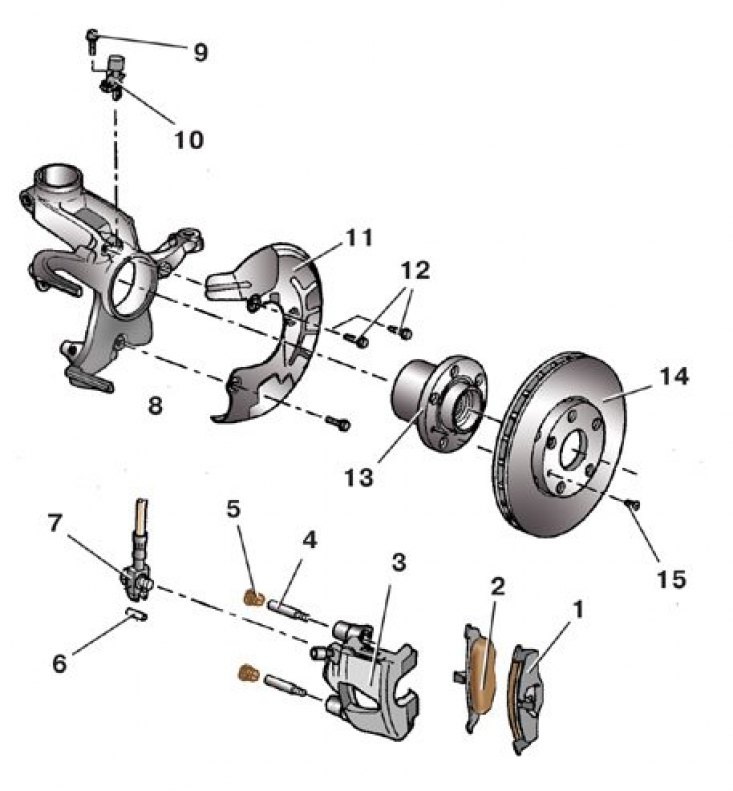
1 - external brake shoe; 2 - internal brake shoe; 3 - support; 4 - guide pin; 5 - protective cap; 6 - elastic rod; 7 – a tip of a brake hose with a hollow bolt and a sealing ring; 8 – rotary fist; 9, 12 - bolts; 10 - wheel speed sensor; 11 - brake shield; 13 - hub; 14 - brake disc; 15 - screw
Fastening of a support of the forward brake mechanism type FS III
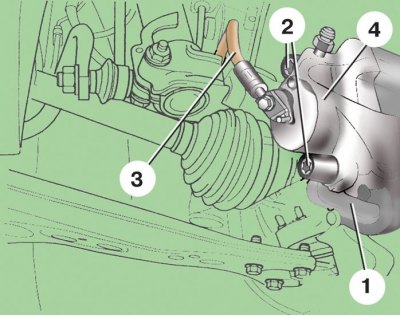
1 – a rotary fist; 2 - guide pin; 3 - brake hose; 4 - support
Removing the brake pads
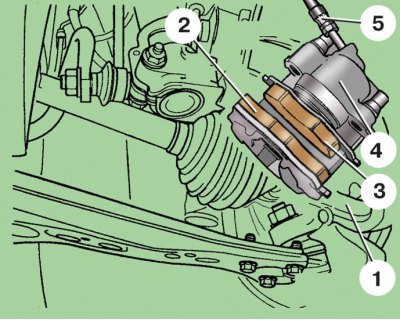
1 – a rotary fist; 2 - external brake shoe; 3 - internal brake shoe; 4 - support; 5 - brake hose
Pushing the piston into the cylinder
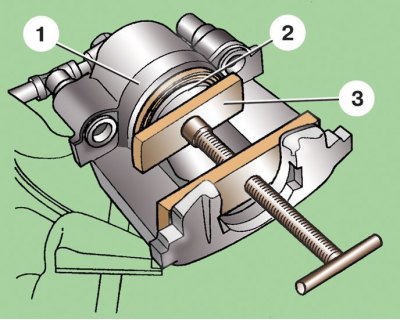
1 – caliper cylinder; 2 - piston; 3 - special device
Internal brake pad
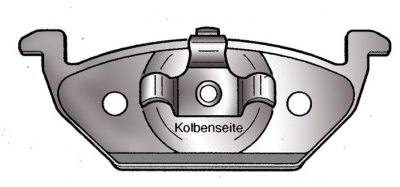
Installing the caliper on the steering knuckle
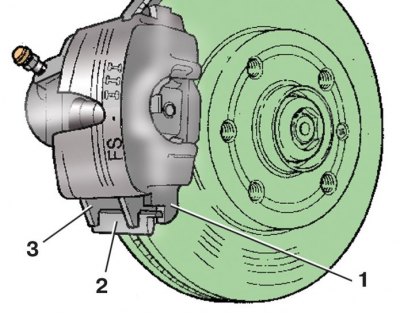
1 - support; 2 - guide pads of the steering knuckle; 3 - brake pads
Replace brake pads in the following cases:
- the thickness of the friction lining is less than the permissible one;
- the surface of the pads is oiled;
- pads are loosely connected to the base;
- there are deep grooves and chips on the overlays.
Attention! Pad sets must be replaced on both sides of the front suspension at the same time.
Attention! Do not use gasoline, diesel fuel or any other mineral solvents to clean the brakes.
1. Remove the wheel by first loosening the bolts of its fastening on the car standing on the ground.
2. Remove protective caps 5 (see fig. Front brake type FS III) guide fingers.
3. Unscrew both guide pins 2 (see fig. Fastening of a support of the forward brake mechanism type FS III).
4. Remove caliper 4 (see fig. Removing the brake pads) from the steering knuckle 1, without disconnecting the brake hose 5 from it. Hang the caliper on a wire to the suspension spring, making sure that the brake hose is not stretched, twisted or strongly bent.
5. Remove brake pads 2 and 3 from caliper 4.
6. Use a rubber bulb to remove part of the brake fluid from the master cylinder reservoir.
7. Clean the caliper. Particularly carefully clean the place of installation of the pads from rust with a metal brush, check that the pads in the caliper move freely.
8. Press piston 2 (see fig. Pushing the piston into the cylinder) into cylinder 1 using special tool 3 or, if it is not available, use, for example, a wooden hammer handle. At the same time, press the piston evenly at different points around the entire circumference, making sure that the piston does not warp.
9. Install brake pads as marked. Block with white marking «Kolbenseite» (see fig. Internal brake pad) must be on the inside (piston side), on the outside, a block with a black marking and a clip with three legs is installed.
10. When installing the caliper, first insert into the guide 2 (see fig. Installing the caliper on the steering knuckle) knuckle pads, its lower part so that the protrusions of the caliper 1 and pads 3 engage from different sides of the guide 2.
11. Screw guide pins 4 (see fig. Front brake type FS III).
12. Install the protective caps of the 5 guide pins.
13. Install the wheel. Final tighten the wheel bolts only with the vehicle on the ground.
14. Replace the pads in the opposite brake in the same way.
15. Press the brake pedal several times to bring the pistons into position.
16. Check and, if necessary, add brake fluid to the required level in the reservoir.
| Nominal lining thickness (with base), mm | 19,6 |
| Minimum allowable friction lining thickness (with base / without base), mm | 7,0/ 2,0 |
Tightening torques, Nm
| Wheel bolts | 120 |
| Guide pins | 28 |
